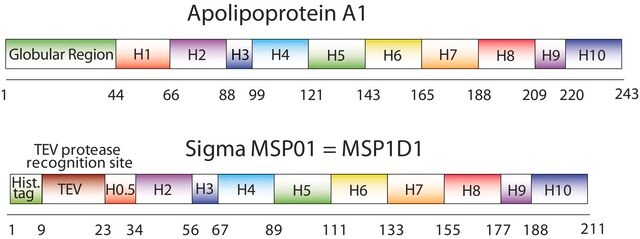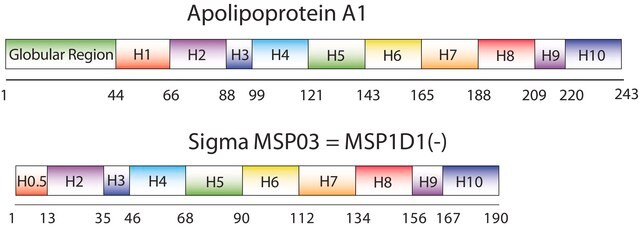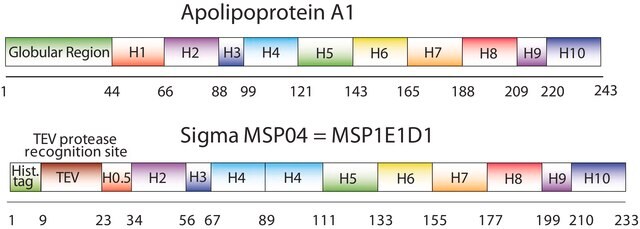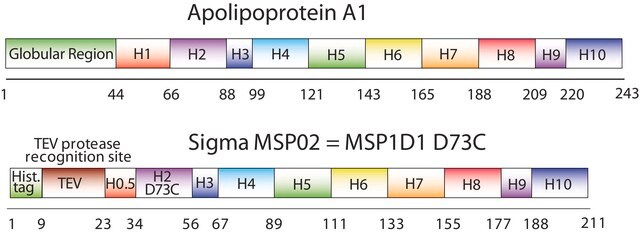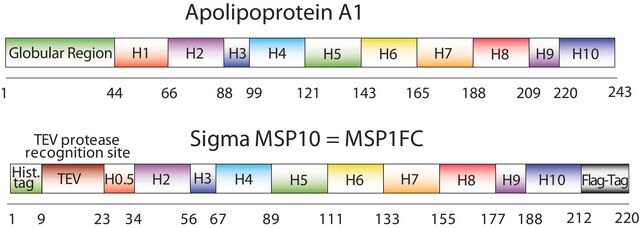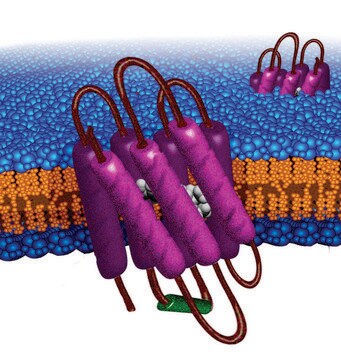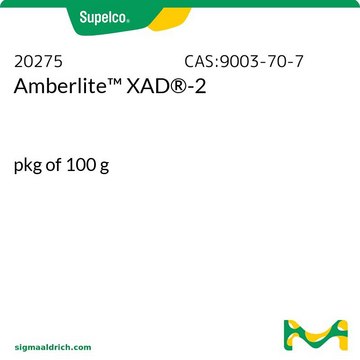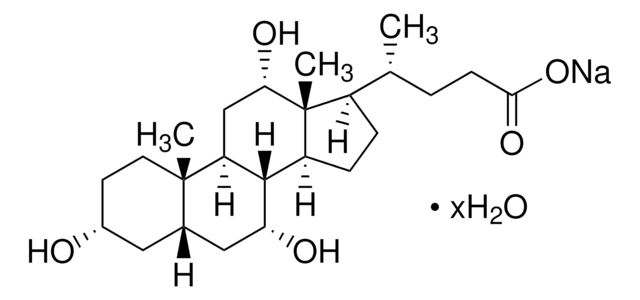推薦產品
生物源
microbial
品質等級
重組細胞
expressed in E. coli
描述
N-Terminal histidine-tagged
形狀
lyophilized powder
分子量
Mw 24661.9 by amino acid sequence
&epsilon ;(消光係數)
18200 M-1cm-1 at 280 nm (His-tag-cleaved dissolved in 20 mM Tris pH 7.4, 0.1M NaCl, 0.5mM EDTA and 0.01%NaN3)(lit.)
21000 M-1cm-1 at 280 nm (uncleaved His-tagged dissolved in 20 mM Tris pH 7.4, 0.1M NaCl, 0.5mM EDTA and 0.01%NaN3)(lit.)
儲存溫度
−20°C
尋找類似的產品? 前往 產品比較指南
應用
关于使用这种和其他MSP制备纳米盘的指南,请访问我们的 膜支架蛋白和纳米盘形成方案页面。
有关引用和协议的详细列表,请访问Sligar Lab网站:sligarlab.life.uiuc.edu/nanodisc.html
纳米盘可溶性脂质双层系统已被证明是一种广泛适用的方法,用于呈现膜蛋白可溶于水溶液中,在类似原生的双层环境中保持单分散和活性。纳米盘的关键组成部分是环绕的两亲性螺旋蛋白带(膜支架蛋白)。
纳米盘系统已经被用于包括 GPCRs 、P450 、细菌视紫红质 、凝血因子 、霍乱毒素 、焦油受体 和芳香化酶 等多种蛋白质的掺入。
膜支架蛋白1D1已用作稳定脂质纳米盘(ND)的支架蛋白。也已用于制备纳米盘。
生化/生理作用
生成直径约为 9.7 nm 的纳米盘
膜支架蛋白1D1 (MSP1D1)源自载脂蛋白A-I。它是一种双亲性合成蛋白质,可以自组装形成纳米盘。
物理性質
序列:GHHHHHHHDYDIPTTENLYFQGSTFSKLREQLGPVTQEFWDNLEKETEGLRQEMSKDLEEVKAKVQPYLDDFQKKWQEEMELYRQKVEPLRAELQEGARQKLHELQEKLSPLGEEMRDRARAHVDALRTHLAPYSDELRQRLAARLEALKENGGARLAEYHAKATEHLSTLSEKAKPALEDLRQGLLPVLESFKVSFLSALEEYTKKLNTQ
外觀
作为冻干的组氨酸标记的蛋白质提供,其中TEV蛋白酶切割位点用Tris-HCl、EDTA和NaCl稳定。
法律資訊
纳米盘技术,以及它的许多用途,都被伊利诺伊大学拥有的以下专利所涵盖。
- 7,691,414 膜支架蛋白
- 7,662,410 膜支架蛋白和包埋膜蛋白
- 7,622,437 组织因子组成和方法
- 7,592,008 膜支架蛋白
- 7,575,763 膜支架蛋白和栓系膜蛋白
- 7,083,958 膜支架蛋白
- 7,048,949 膜支架蛋白
相關產品
產品號碼
描述
訂價
訊號詞
Warning
危險聲明
危險分類
Eye Irrit. 2 - Skin Irrit. 2 - STOT SE 3
標靶器官
Respiratory system
儲存類別代碼
11 - Combustible Solids
水污染物質分類(WGK)
WGK 3
閃點(°F)
Not applicable
閃點(°C)
Not applicable
客戶也查看了
Time-course and degradation rate of membrane scaffold protein (MSP1D1) during recombinant production
Faas R, et al.
Biotechnology reports (Amsterdam, Netherlands), 17, 45-48 (2018)
Lipid nanotechnologies for structural studies of membrane-associated proteins
Stoilova-McPhie S, et al.
Proteins: Structure, Function, and Bioinformatics, 82(11), 2902-2909 (2014)
Lipid nanotechnologies for structural studies of membrane-associated proteins.
Stoilova-McPhie, S., et al.
Proteins: Structure, Function, and Genetics, 82(11), 2902-2909 (2014)
Synaptosomes (2018)
Tomasz Uchański et al.
Nature methods, 18(1), 60-68 (2021-01-08)
Nanobodies are popular and versatile tools for structural biology. They have a compact single immunoglobulin domain organization, bind target proteins with high affinities while reducing their conformational heterogeneity and stabilize multi-protein complexes. Here we demonstrate that engineered nanobodies can also
文章
Read our article about how the Nanodisc system allows for structural studies of membrane proteins.
條款
Protocols for Membrane Scaffold Proteins and Nanodisc Formation
我們的科學家團隊在所有研究領域都有豐富的經驗,包括生命科學、材料科學、化學合成、色譜、分析等.
聯絡技術服務